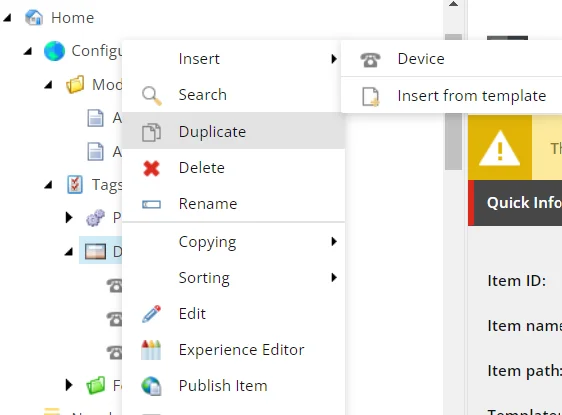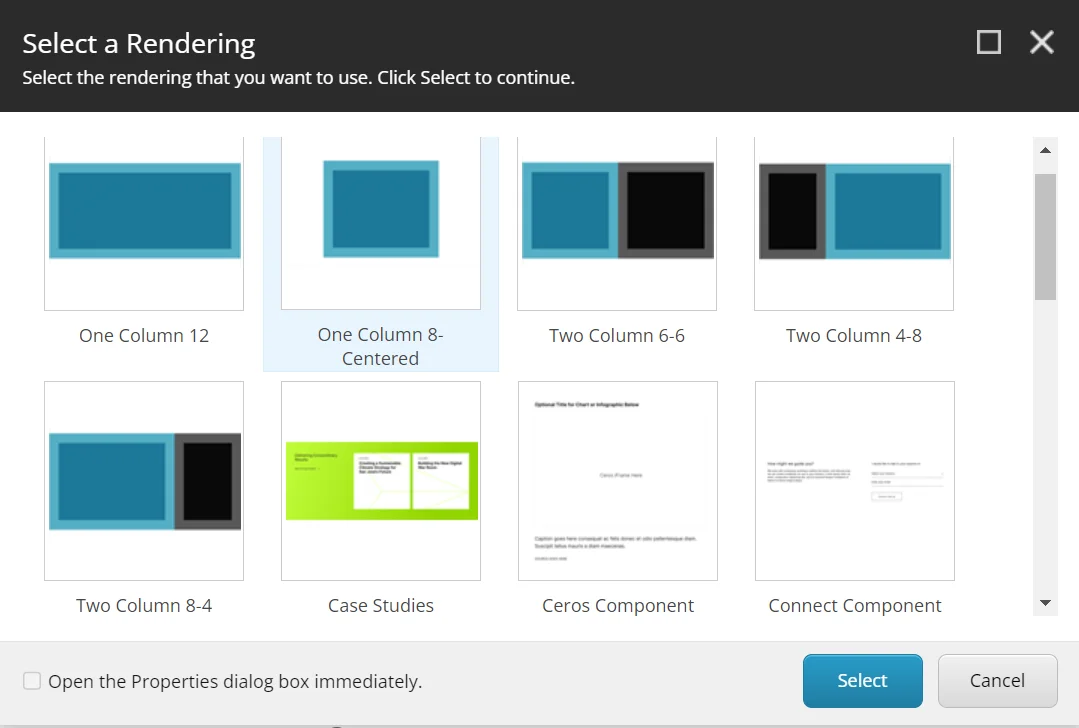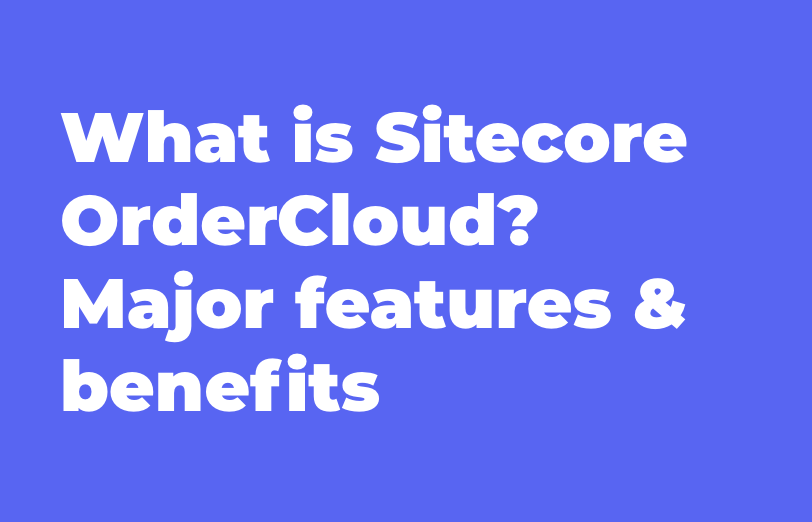Sitecore is a powerful enterprise content management system (CMS) that can be used to create and
manage complex websites.
We have to follow below best practices to create proper structure in CMS so it will be helpful
for the content editor/author to manage content from CMS. Here are the best practices that you
must follow as a Sitecore developer.
-
Insert Options
In Sitecore, "Insert Options" allow you to define which types of items can be created as
child items of a specific item, as well as the order in which those items appear in the
Insert Options menu. Here are the steps to use the "Insert Options" feature in Sitecore:
When an author selects the "Insert" option, they can choose from a variety of pre-defined
templates or create a new item based on a custom template. This allows authors to
quickly and easily create new pages, articles, images, or other content items that
follow the site's design and structure.
See the below example, when the content author clicks on the device item folder, they
will be able to see the Device in the template list.

-
Rendering Datasource Location
Sitecore, the Rendering Datasource Location refers to the location in the content tree
where a rendering can retrieve its data source from. This feature allows authors to
specify a different data source for each instance of a rendering on a page, giving them
greater control over the content displayed on the page.
Once the Rendering Datasource Location is configured for a rendering, the rendering will
retrieve its data from the specified location in the content tree

-
Rendering Datasource Template
In Sitecore, the Rendering Datasource Template is a feature that allows authors to
specify a template that controls the content that can be used as a data source for a
particular rendering.
Once the Rendering Datasource Template is configured for a rendering, only items in the
content tree that are based on the specified template can be used as a data source for
the rendering.

-
Standard Values
Standard values in Sitecore are used to define default field values and settings for
content items that share a template. When a new item is created based on a template that
has standard values defined, the new item will inherit the default field values and
settings from the standard values.
Like, we have created header and footer component and we have to apply in all the pages
so we can define standard value for that page template and set that component in that
page standard value item.
-
Token
In Sitecore, tokens are placeholders that can be used in fields to dynamically populate
content with information such as the current date, the name of the current user, or the
URL of the current item.
Like $name, $date, $userename, $url, $id etc

-
Rendering Icon
In Sitecore, a rendering icon is a small icon that appears next to the name of a
rendering in the Presentation Details of an item. The rendering icon provides a quick
visual indicator of the type of rendering and can help authors to identify and manage
renderings more easily.
Let say we have created banner component or promo component at that time we can configure
icon based on that component look and feel. So, when content author select component in
content editor or experience editor, they can easily identify the component based on the
icon image.

-
Placeholder Allow control Settings
In Sitecore, Placeholder Allow Control Settings are used to define which renderings are
allowed to be placed in a particular placeholder on a page. This feature allows site
administrators to control the types of content that can be added to different areas of a
page, improving the consistency and quality of the site.
In Sitecore, Placeholder Allow Control Settings are used to define which renderings are
allowed to be placed in a particular placeholder on a page. This feature allows site
administrators to control the types of content that can be added to different areas of a
page, improving the consistency and quality of the site.
-
Use Droplink instead of Droplist fields.
Droplist stores the text of the option, which could make referential integrity problem.
Droplist store the id of target item. Which will help to get the targeted item.
-
Use inheritance for reusable fields.
Sitecore inheritance reduce the unnecessary redundancy in item data definition templates.
Use already created template when we create the new template.
-
Instead of Items names in the Content Editor, use Display names. This will help with
readability.
Display Names can be used in Sitecore Content Editor to provide a more readable and
user-friendly view of items in the content tree. Display Names can be used to replace
the item names in the tree with more descriptive and meaningful names that better
represent the content of the item
By default, Sitecore uses the item name as the display name in the Content Editor.
However, if the item name contains special characters, numbers, or abbreviations, it can
be difficult for authors to quickly identify the purpose of the item. Display Names can
help to overcome this issue by providing a more natural language name that is easier to
understand.
Sometimes, item names can get long for SEO purposes, but this is unnecessary. As they are
used in the URLs, you use the Display names for showing a short name that includes
special characters.

-
Provide field Tooltip information
Field tooltips can be used in Sitecore to provide additional information and guidance to
authors when editing content.
When you will create template, you can find Help section in every field in standard Field
section where you can define Help text.

After adding the Shot and long description, you can see below information when content
editor will add the content.

-
Use branch templates for predefined content structures
Using branch templates, we can save time for authors and ensure consistency across the
site. Instead of creating each individual item and defining the fields and settings
manually, authors can create a new content item based on a branch template and quickly
create a pre-defined structure with all the necessary fields and settings.
-
Shared field
When you are creating multilingual websites at that time you have to take care of
creating templates. Because when we have multiple language websites at that time image,
the link is mostly common in all the language website. Make sure when you will create
the template, that this field is marked as a shared field.
-
Language Fallback
When you are working in multiple language websites at that time this configuration is
very important. Sitecore provide two kinds of fallback, item level, and field level
fallback. Wenever you have no data for secondary language at that time primary language
data will be returned.
Item Fallback

Field Fallback

-
Unique field name
Make sure you can provide unique name of your template field.
Each field in Sitecore has a unique Field ID, which is a GUID (Globally Unique
Identifier) that is generated when the field is created. The Field ID is used by
Sitecore to uniquely identify the field and is used in various places throughout the
system, such as in the content tree, in code, and in database tables.
Same case same field name,
-
Configure Page/Template icon
-
Multilist/Treelist field assign specific data source or query
By following the above given practices, you will be able to ensure that you are working on
Sitecore CMS effectively and efficiently.
BACK TO SERVICE LIST
Sitecore Module Development Add new features, extend new features, or even replace, supplement and provide new functionality to Sitecore. Sitecore CMP & MRM Through the Sitecore CMP & MRM, drive execution, workflow, operations and processes of your entire marketing team. Sitecore Ordercloud Create a dynamic eCommerce platform and future-proof your business for B2B, B2C, B2X or any other marketplace business model. Sitecore Discover Provide real-time, personalized search results and recommendations for every individual shopper, all in one place.
MAIN MENU
























